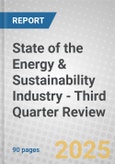The global market for ship recycling is estimated to grow from $9.1 billion in 2025 to reach $13 billion by the end of 2030, at a CAGR of 7.4% from 2025 to 2030.
The global market for membrane bioreactors is estimated to grow from $4.4 billion in 2025 to reach $9.4 billion by the end of 2030, at a CAGR of 16.1% from 2025 to 2030.
The energy industry is in a strategy reset, shaped by decarbonization, supply security and cost discipline. In oil and gas, supermajors and NOCs are balancing advantaged barrels (LNG, deepwater, petrochemicals) with low-carbon options (CCUS, hydrogen, advanced biofuels) while keeping shareholder returns front and center. Power markets are scaling renewables and storage, but the chokepoint is the grid - interconnection queues, permitting and flexibility. Water stress is now a core business risk: utilities and industry are investing in reuse, desalination and advanced membranes to cut energy per m³ and meet PFAS and micro-contaminant rules. Fuel cells and hydrogen are concentrating on heavy-duty, backup power and industrial heat rather than passenger cars. Food and manufacturing are chasing energy productivity, electrifying process heat where possible, tightening steam systems, upgrading motors and drives and monetizing waste heat and biogas. Strategically, big companies are sharpening portfolios and partnerships - ExxonMobil, Shell, BP and TotalEnergies on the hydrocarbonlow- carbon barbell; Siemens Energy, GE Vernova and Hitachi Energy on grid and flexible generation; Veolia, Xylem, Ecolab, DuPont/Toray on water and membranes; Toyota, Hyundai, Cummins (Accelera), Plug Power and Ballard on fuel cells; and global food majors (Nestlé, PepsiCo, AB InBev) linking Scope 1-3 cuts to supplier programs.
AI is moving from pilots to productivity. In upstream and LNG, it improves subsurface imaging, production optimization and methane detection; in power, it forecasts load/renewables, orchestrates DERs and reduces outages; in water, it enables smart dosing, fouling prediction and energy-optimal RO; in manufacturing and food, it drives predictive maintenance, yield control and utility optimization; and in materials, it accelerates membrane and catalyst discovery. Macro headwinds - tariffs, local-content rules and volatile gas and power prices - are fragmenting supply chains and raising the value of regional capacity and long-term offtakes. The near-term playbook is pragmatic: prioritize projects with fast cash payback (efficiency, grid upgrades, water reuse), build optionality in hydrogen and CCUS with staged investments, pair AI with high-quality operational data and hard-wire sustainability into procurement. The opportunity set is largest where decarbonization, reliability and cost intersect - electrified industrial heat, flexible generation and storage, high-recovery water systems and circular resource use across food and manufacturing.








